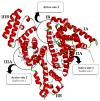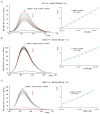Copper(II) and Zinc(II) Complexes with Bacterial Prodigiosin Are Targeting Site III of Bovine Serum Albumin and Acting as DNA Minor Groove Binders
- PMID: 39125963
- PMCID: PMC11313072
- DOI: 10.3390/ijms25158395
Copper(II) and Zinc(II) Complexes with Bacterial Prodigiosin Are Targeting Site III of Bovine Serum Albumin and Acting as DNA Minor Groove Binders
Abstract
The negative environmental and social impacts of food waste accumulation can be mitigated by utilizing bio-refineries' approach where food waste is revalorized into high-value products, such as prodigiosin (PG), using microbial bioprocesses. The diverse biological activities of PG position it as a promising compound, but its high production cost and promiscuous bioactivity hinder its wide application. Metal ions can modulate the electronic properties of organic molecules, leading to novel mechanisms of action and increased target potency, while metal complex formation can improve the stability, solubility and bioavailability of the parent compound. The objectives of this study were optimizing PG production through bacterial fermentation using food waste, allowing good quantities of the pure natural product for further synthesizing and evaluating copper(II) and zinc(II) complexes with it. Their antimicrobial and anticancer activities were assessed, and their binding affinity toward biologically important molecules, bovine serum albumin (BSA) and DNA was investigated by fluorescence emission spectroscopy and molecular docking. The yield of 83.1 mg/L of pure PG was obtained when processed meat waste at 18 g/L was utilized as the sole fermentation substrate. The obtained complexes CuPG and ZnPG showed high binding affinity towards target site III of BSA, and molecular docking simulations highlighted the affinity of the compounds for DNA minor grooves.
Keywords: DNA interactions; Serratia marcescens; bio-refinery; metal complexation; prodigiosin; protein interactions; waste.
Conflict of interest statement
The authors declare no conflict of interest.
Figures









Similar articles
-
Synthesis and structure elucidation of new μ-oxamido-bridged dicopper(II) complex with in vitro anticancer activity: A combined study from experiment verification and docking calculation on DNA/protein-binding property.J Photochem Photobiol B. 2016 Feb;155:86-97. doi: 10.1016/j.jphotobiol.2015.12.015. Epub 2015 Dec 23. J Photochem Photobiol B. 2016. PMID: 26773872
-
Example of two novel thiocyanato bridged copper (II) complexes derived from substituted thiosemicarbazone ligand: structural elucidation, DNA/albumin binding, biological profile analysis, and molecular docking study.J Biomol Struct Dyn. 2019 Jul;37(11):2801-2822. doi: 10.1080/07391102.2018.1503564. Epub 2018 Dec 10. J Biomol Struct Dyn. 2019. PMID: 30101692
-
Synthesis and crystal structure of new dicopper(II) complexes having asymmetric N,N'-bis(substituted)oxamides with DNA/protein binding ability: In vitro anticancer activity and molecular docking studies.J Photochem Photobiol B. 2015 Aug;149:129-42. doi: 10.1016/j.jphotobiol.2015.05.014. Epub 2015 May 27. J Photochem Photobiol B. 2015. PMID: 26057022
-
Synthesis, crystal structures, anticancer activities and molecular docking studies of novel thiazolidinone Cu(II) and Fe(III) complexes targeting lysosomes: special emphasis on their binding to DNA/BSA.Dalton Trans. 2021 Oct 5;50(38):13387-13398. doi: 10.1039/d1dt02180j. Dalton Trans. 2021. PMID: 34473154
-
A phenanthroline-based erbium (III) complex: molecular docking, DNA/BSA -binding and biological evaluation.J Biomol Struct Dyn. 2025 May;43(8):3873-3885. doi: 10.1080/07391102.2023.2300130. Epub 2024 Jan 4. J Biomol Struct Dyn. 2025. PMID: 38174386 Review.
Cited by
-
Innovative Approaches in the Synthesis and Optimization of Copper Complexes for Antitumor Therapies: A Comprehensive Review.Molecules. 2025 May 9;30(10):2104. doi: 10.3390/molecules30102104. Molecules. 2025. PMID: 40430277 Free PMC article. Review.
-
(Alkyl-ω-ol)triphenyltin(IV)-Loaded Mesoporous Silica as Biocompatible Potential Neuroprotectors: Evaluation of Inhibitory Activity Against Enzymes Associated with the Pathophysiology of Alzheimer's Disease.Nanomaterials (Basel). 2025 Jun 12;15(12):914. doi: 10.3390/nano15120914. Nanomaterials (Basel). 2025. PMID: 40559280 Free PMC article.
-
Dinuclear Gallium(III) Complex With 1,3-Propanediamine-N,N'-Diacetate: Structural Characterization, Antimicrobial Activity, and DNA/BSA Interactions.Bioinorg Chem Appl. 2025 Apr 12;2025:8097589. doi: 10.1155/bca/8097589. eCollection 2025. Bioinorg Chem Appl. 2025. PMID: 40260129 Free PMC article.
References
-
- Gustavsson J., Cederberg C., Sonesson U., van Otterdijk R., Meybeck A. Global Food Losses and Food Waste: Extent, Causes and Prevention. Food and Agriculture Organization of the United Nations; Rome, Italy: 2011.
-
- Venil C.K., Zakaria Z.A., Ahmad W.A. Bacterial pigments and their applications. Process Biochem. 2013;48:1065–1079. doi: 10.1016/j.procbio.2013.06.006. - DOI
MeSH terms
Substances
Grants and funding
- 7730810/Science Fund of the Republic of Serbia
- 451-03-66/2024-03/200042/Ministry of Science, Technological Development and Innovations of the Republic of Serbia
- 451-03-65/2024-03/200122/Ministry of Science, Technological Development and Innovations of the Republic of Serbia
- 451-03-66/2024-03/200122/Ministry of Science, Technological Development and Innovations of the Republic of Serbia
- 451-03-66/2024-03/200378/Ministry of Science, Technological Development and Innovations of the Republic of Serbia
LinkOut - more resources
Full Text Sources
Molecular Biology Databases

